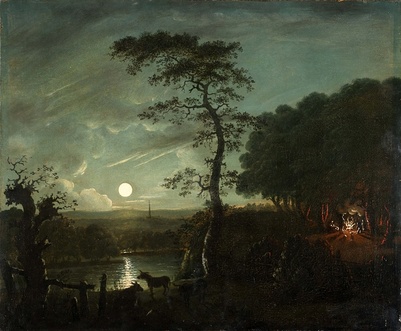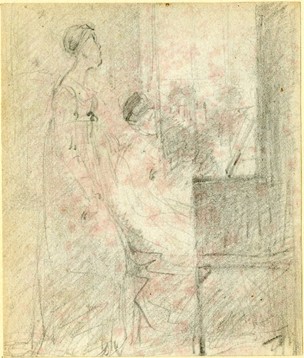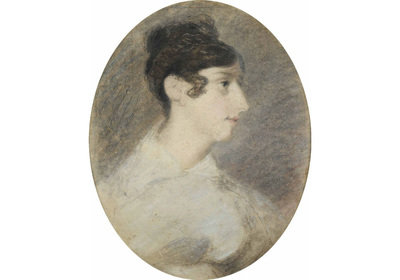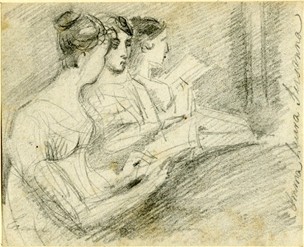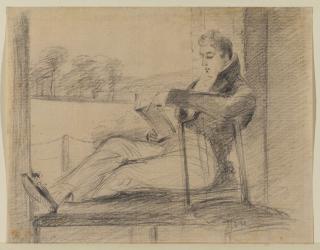John Constable: Tottenham Connections
Introduction to the Royal Academy
John Constable, the Romantic painter, travelled to Tottenham Green in April 1799 to visit Priscilla Wakefield who lived to the east of the High Road. She records a meeting with Constable, presumably at her home in Tottenham:
Mr Constable paid me an unexpected visit to dinner and tea. At this time BG Windus was nine years old. Priscilla Wakefield, a prominent Quaker and author, was active in improving the lives of girls and women, the abolition of slavery and prison reform. She had met John Constable on 29 January 1799 at the home of the Cobbolds, an important landowning Quaker family, in Ipwich, Suffolk. Priscilla Wakefield recorded in her diary: Spent the evening at Mrs Cobbold’s—met there Mr. J. Constable a pleasing modest young man—who had a natural genius for painting. She provided Constable with his introduction to Joseph Farington, a Royal Academician. Constable visited Joseph Farington regularly over the next few years; the following entries in Farington’s diary for 1799 record some of these visits: On 25 February : Mr J. Constable of Ipswich calld, with letter from Mrs. W. devoted to art therefore not necessary to profess it. On 26 February: Constable calld. and brot. his sketches of Landscapes in neighberoud of Dedham. Father a Merct. who has now consented that C. shall devote his time to the study of Art. Wishes to be in Academy—I told him he must prepare a figure. On 2 March: Constable called—shewed him Ruysdael—brot. drawing of torso for admission to Acad. On 4 March: J. Constable called. Gave him letter of introduction to Wilton. On 10 February 1829: J.C. elected a Royal Academician. William Turner and George Jones call on J.C. to tell him of his success in the election to Royal Academy, stays until one o’clock in the morning. |
Letters from ConstableOn 4 March 1799 Constable wrote from London to John Dunthorne, Senior:
I am this morning admitted a student at the Royal Academy [actually, at this time, J.C. was admitted only as a probationer in the Antique Academy]; the figure I drew for admittance was the Torso. And he says he plans to copy 'a sweet little picture by Jacob Ruysdael'. According to the National Trust entry for Flatford: John Dunthorne was a passionate landscape painter. As there were no artists in the Constable household, John Dunthorne provided the friendship and support that John Constable needed and it was from John Dunthorne that John Constable learnt to be methodical and to observe/paint closely from nature. On 17 December 1815 Constable wrote from East Bergholt, to his fiancée, Maria, in London: I am hard at work with my picture, which I trust I shall soon be able to give you a good account of—but I have no idea at present of returning to London, without it is for one day. . . . Mrs. Wakefeild [sic] did me a very signal service on my first coming to London—by giving me a letter of recommendation to Mr Farington. For further information on John Constable's diary and letters see John Constable: toward A Complete Chronology edited by Charles S. Rhyne, Professor of Art History, Reed College. Published by the Editor, Portland, Oregon 1990. |
|
There is a painting of All Hallows church in the Metropolitan Museum in New York thought, until recently, to have been painted by Constable.
To find out more click on the button on the right. |
Stay with the Hobson family
During June and July 1806 John Constable spent several weeks at Markfield House in Tottenham as a guest of William Hobson a well known Quaker building contractor. It is likely that he was introduced to the family by Priscilla Wakefield.
It is thought that Constable was invited to teach drawing to the daughters of the family and he sketched portraits of the Hobson’s 13 daughters and three sons during his stay. Two of the sketch books are now in the Louvre in Paris but individual drawings are held in various museums and galleries in the UK. From a Quaker background William Hobson was criticised for ‘encouraging diversions in his house’: he had a billiard table, kept a box at the Opera and was addicted to hunting. His wife, Ann, was also censured by the Southwark Monthly Meeting because ‘she encourages and approves of her children being taught the practice of music’. When they moved to Tottenham Ann was visited by members of the local Monthly Meeting, and because she persisted in encouraging music and dancing at home, was disowned in 1804. Did BG Windus, who would have been 16 at the time of Constable’s visit, join the Hobson family for any of their entertainments? |
Laura Hobson, John Constable and Lucian Freud
A portrait of Laura Hobson of Markfield House in South Tottenham painted by John Constable was owned by the artist, Lucian Freud. Constable drew Laura, the fourth daughter of William Hobson, the prosperous building contractor, when he visited the family home in 1806. Laura married Captain Robert Moubray the following year and he commissioned this portrait of his wife from Constable. Robert Moubray of Cockairny and Otterston, was a deputy lieutenant of Fifeshire who lived between 1774 and 1848.
|
This rare Constable portrait passed by descent within the family until it was sold at Christie’s in 1992 when it was bought by Lucian Freud. The painting was acquired for the Nation in 2013 through the Government’s Acceptance in Lieu (AIL) scheme and allocated to the Scottish National Gallery. It was the first Constable portrait to enter a Scottish collection.
Freud was a great admirer of Constable’s portraits, describing him as an incredibly emotive painter, in the true sense of the word and that he:
always thought that it was completely loopy for people to go on about portrait painters, English portrait painters, and not to have Constable among them!
Of the portrait the Art Tribune notes that Constable:
… paid particular attention to the model’s face, illuminating it with a single ray of light and making it stand out against a neutral and somber background,
whereas the clothing is rapidly brushed in. The painter did not attempt to idealize the young woman ; his choice of showing her in profile underscores her
upturned nose, round chin and the slightly pouting mouth.
Michael Clarke, director of the Scottish National Gallery, said at the time of the acquisition:
We are absolutely thrilled to receive this charming and intriguing picture. Lucian Freud had a very discerning eye and
now our public will also be able to appreciate the qualities Freud found in Constable’s rare and unusual portraits.
According to the Cultural Gifts Scheme and Acceptance in Lieu Scheme panel:
Constable initially began painting portraits to generate income but soon acquired considerable skill in the genre, specifically in his ability to convey
character through expressive brushwork, which is particularly evident in the individual portraits he painted of his family, friends and peers. Often
compositionally awkward and relatively lacking in sophistication, these portrayals are refreshingly honest and raw in execution. Furthermore,
they serve as intimate documents of the artist’s personal life, revealing not only a sense of the various people they depict but also the artist’s
relationship to them. It is doubtless that these qualities in particular appealed to Lucian Freud.
The Pre-eminence criteria used in assessing objects offered under the scheme are:
1. does the object have an especially close association with our history and national life?
2. is the object of especial artistic or art-historical interest?
3. is the object of especial importance for the study of some particular form of art,
learning or history?
4. does the object have an especially close association with a particular historic setting?
The Panel considered Portrait of Laura Moubray to be pre-eminent under the third criterion, in acceptable condition and offered at a fair market value.
Freud was a great admirer of Constable’s portraits, describing him as an incredibly emotive painter, in the true sense of the word and that he:
always thought that it was completely loopy for people to go on about portrait painters, English portrait painters, and not to have Constable among them!
Of the portrait the Art Tribune notes that Constable:
… paid particular attention to the model’s face, illuminating it with a single ray of light and making it stand out against a neutral and somber background,
whereas the clothing is rapidly brushed in. The painter did not attempt to idealize the young woman ; his choice of showing her in profile underscores her
upturned nose, round chin and the slightly pouting mouth.
Michael Clarke, director of the Scottish National Gallery, said at the time of the acquisition:
We are absolutely thrilled to receive this charming and intriguing picture. Lucian Freud had a very discerning eye and
now our public will also be able to appreciate the qualities Freud found in Constable’s rare and unusual portraits.
According to the Cultural Gifts Scheme and Acceptance in Lieu Scheme panel:
Constable initially began painting portraits to generate income but soon acquired considerable skill in the genre, specifically in his ability to convey
character through expressive brushwork, which is particularly evident in the individual portraits he painted of his family, friends and peers. Often
compositionally awkward and relatively lacking in sophistication, these portrayals are refreshingly honest and raw in execution. Furthermore,
they serve as intimate documents of the artist’s personal life, revealing not only a sense of the various people they depict but also the artist’s
relationship to them. It is doubtless that these qualities in particular appealed to Lucian Freud.
The Pre-eminence criteria used in assessing objects offered under the scheme are:
1. does the object have an especially close association with our history and national life?
2. is the object of especial artistic or art-historical interest?
3. is the object of especial importance for the study of some particular form of art,
learning or history?
4. does the object have an especially close association with a particular historic setting?
The Panel considered Portrait of Laura Moubray to be pre-eminent under the third criterion, in acceptable condition and offered at a fair market value.
